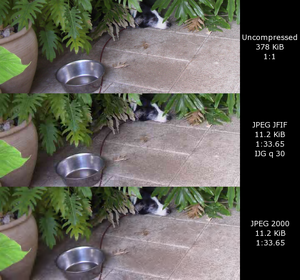JPEG 2000

Comparison of JPEG 2000 with the original JPEG format.
|
|
| Filename extension | .jp2, .j2k, .jpf, .jpx, .jpm, .mj2 |
|---|---|
| Internet media type | image/jp2, image/jpx, image/jpm, video/mj2 |
| Uniform Type Identifier (UTI) | public.jpeg-2000 |
| Developed by | Joint Photographic Experts Group |
| Type of format | graphics file format |
| Standard | ISO/IEC 15444 |
JPEG 2000 (JP2) is an image compression standard and coding system. It was created by the Joint Photographic Experts Group committee in 2000 with the intention of superseding their original discrete cosine transform-based JPEG standard (created in 1992) with a newly designed, wavelet-based method. The standardized filename extension is .jp2 for ISO/IEC 15444-1 conforming files and .jpx for the extended part-2 specifications, published as ISO/IEC 15444-2. The registered MIME types are defined in RFC 3745. For ISO/IEC 15444-1 it is image/jp2.
JPEG 2000 code streams are regions of interest that offer several mechanisms to support spatial random access or region of interest access at varying degrees of granularity. It is possible to store different parts of the same picture using different quality.
As of 2017, there are very few digital cameras that shoot photos in the JPEG 2000 format, and support for viewing and editing photos in this format remains limited.
While there is a modest increase in compression performance of JPEG 2000 compared to JPEG, the main advantage offered by JPEG 2000 is the significant flexibility of the codestream. The codestream obtained after compression of an image with JPEG 2000 is scalable in nature, meaning that it can be decoded in a number of ways; for instance, by truncating the codestream at any point, one may obtain a representation of the image at a lower resolution, or signal-to-noise ratio – see scalable compression. By ordering the codestream in various ways, applications can achieve significant performance increases. However, as a consequence of this flexibility, JPEG 2000 requires encoders/decoders that are complex and computationally demanding. Another difference, in comparison with JPEG, is in terms of visual artifacts: JPEG 2000 only produces ringing artifacts, manifested as blur and rings near edges in the image, while JPEG produces both ringing artifacts and 'blocking' artifacts, due to its 8×8 blocks.
...
Wikipedia
